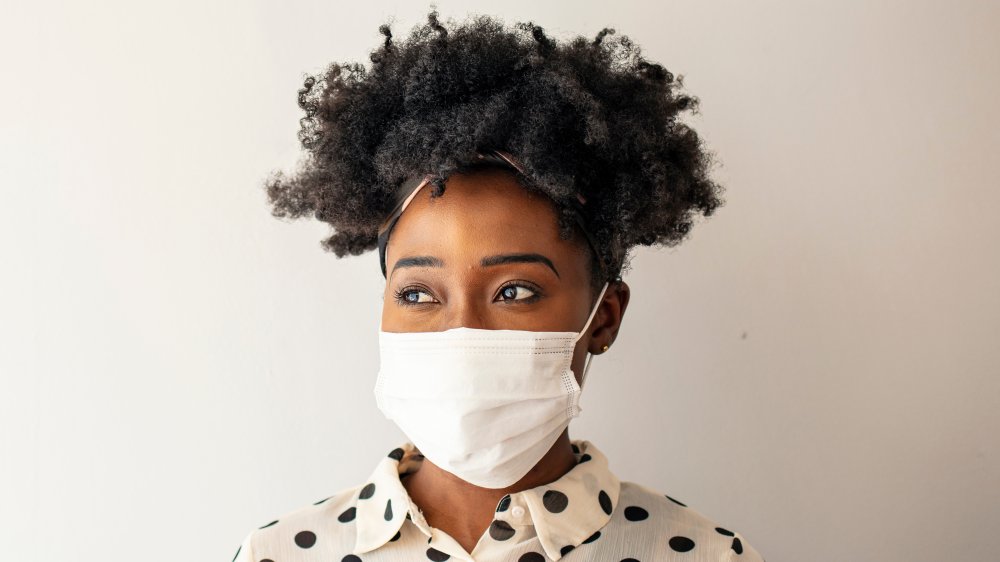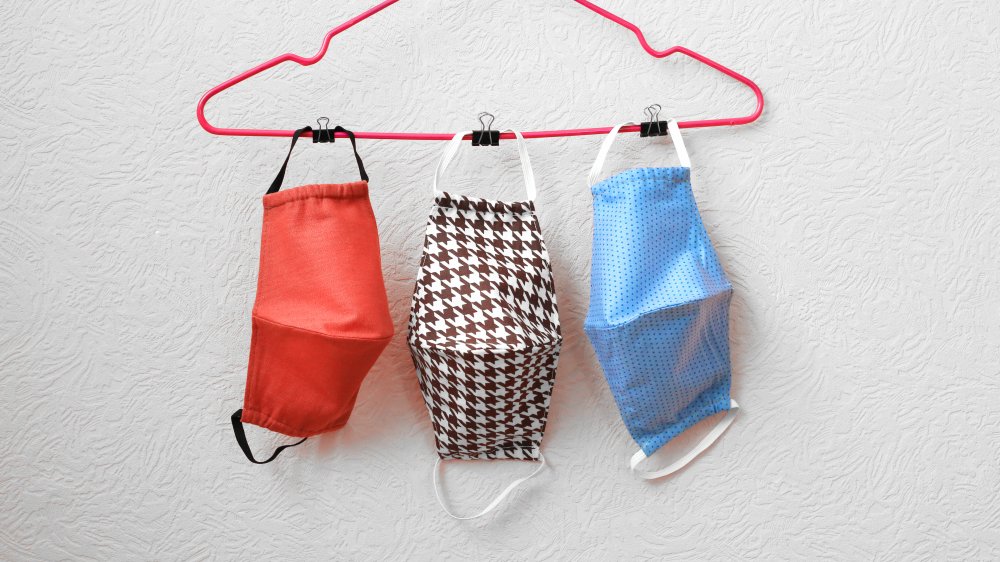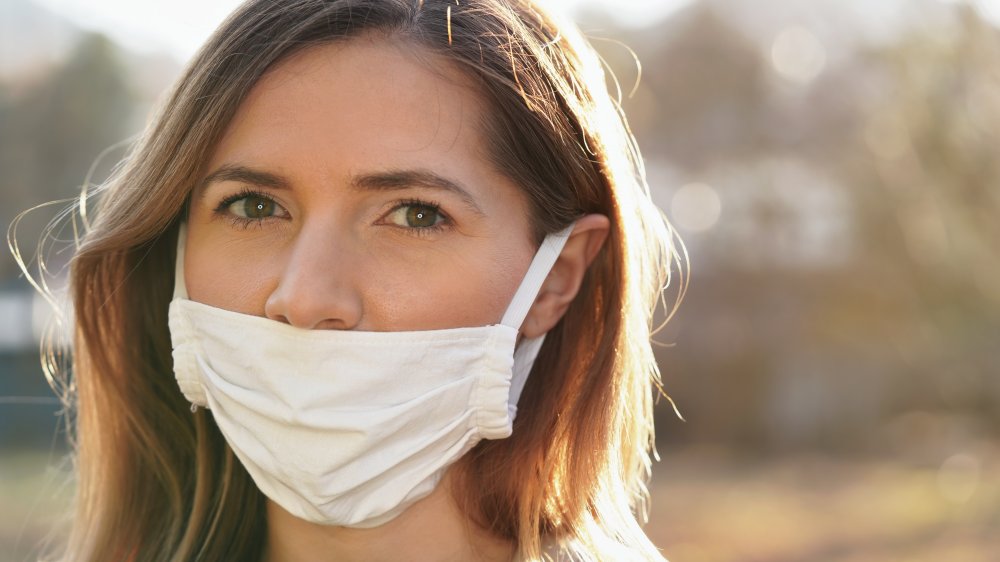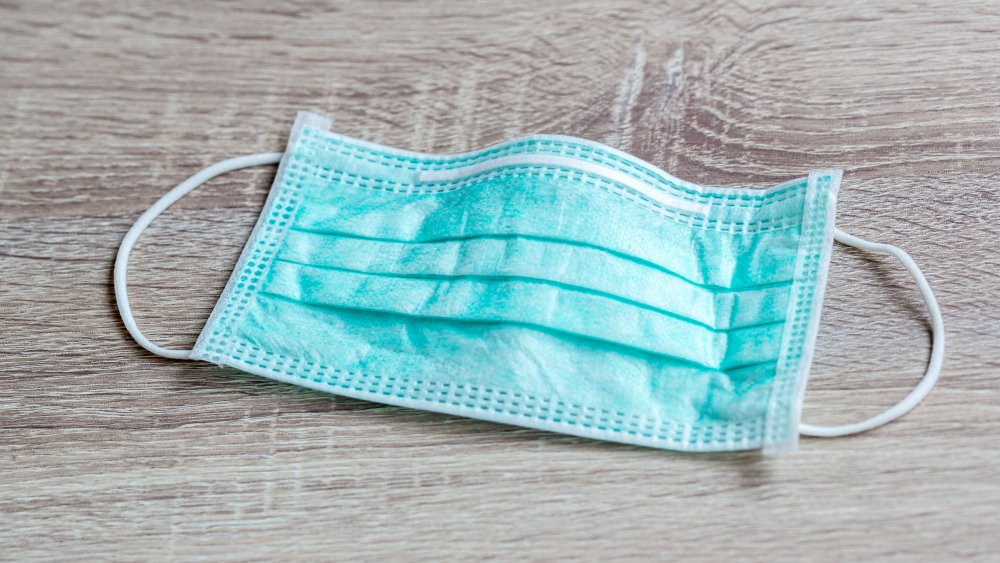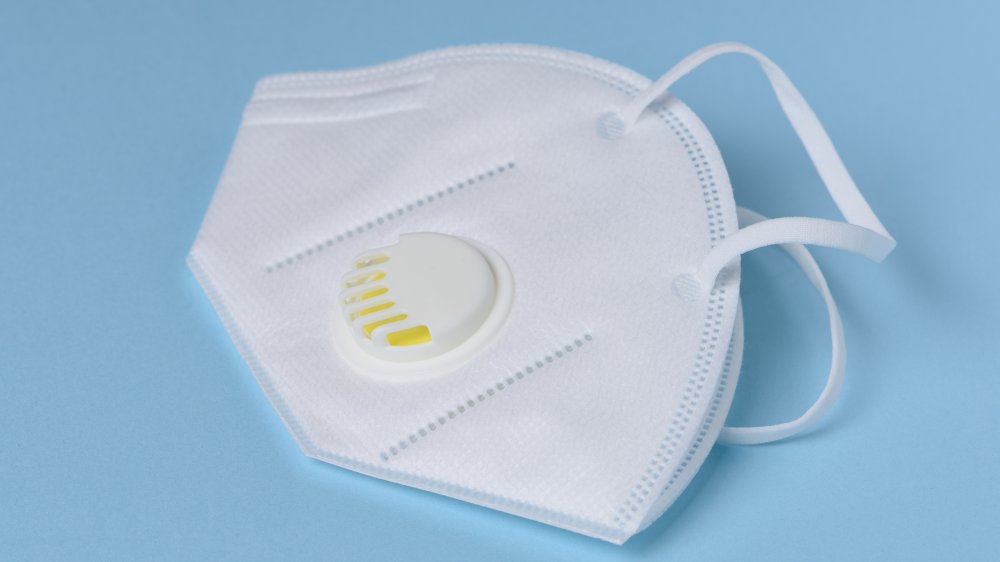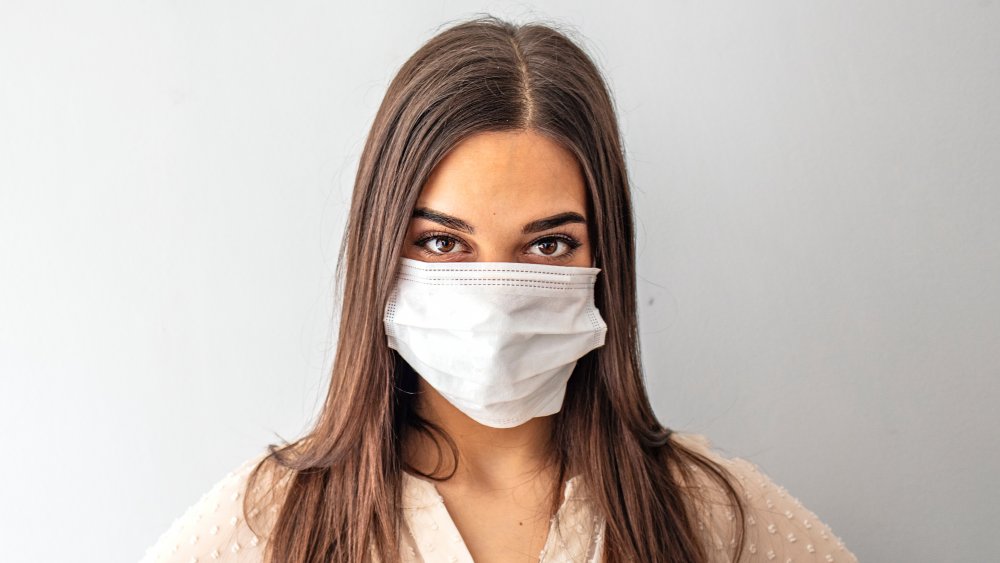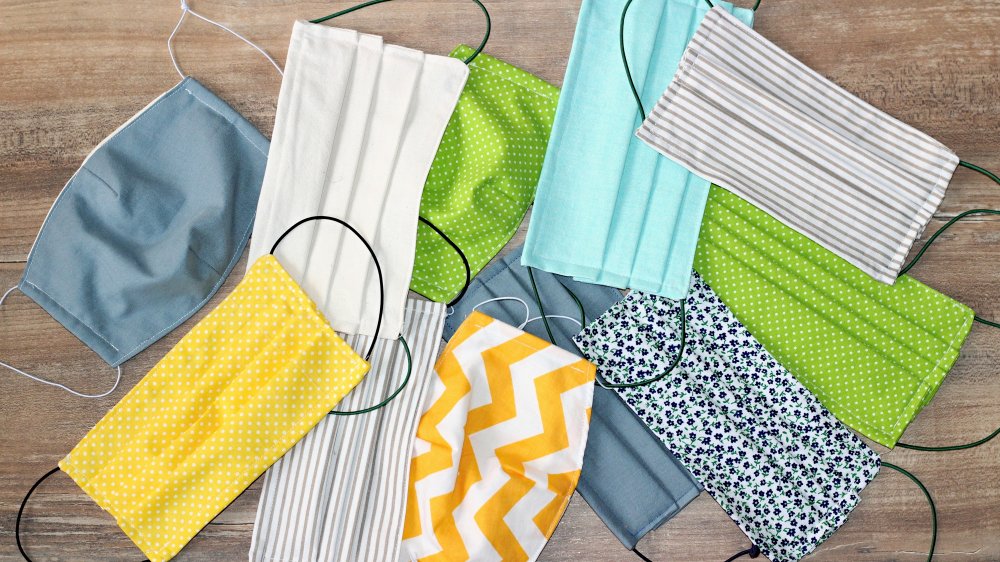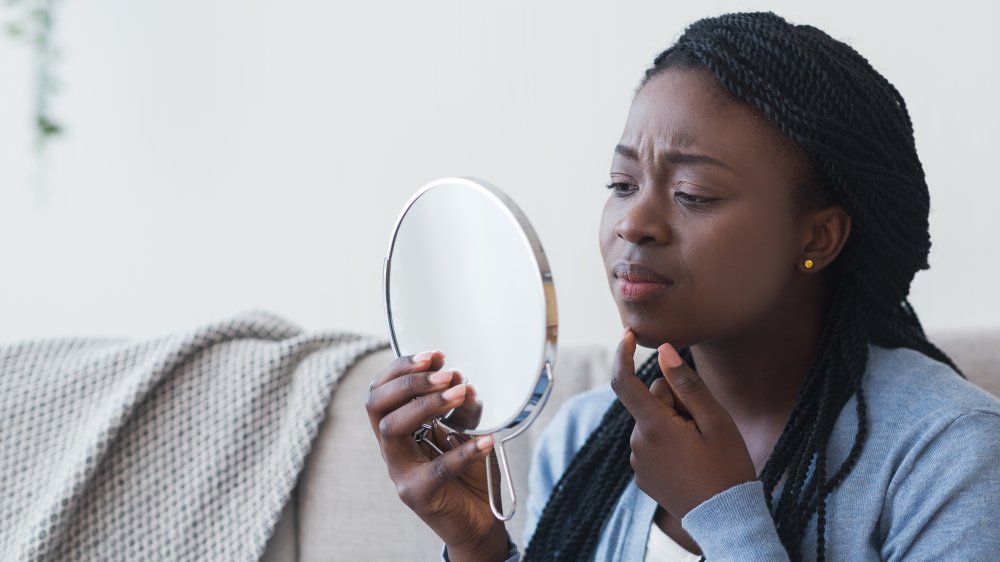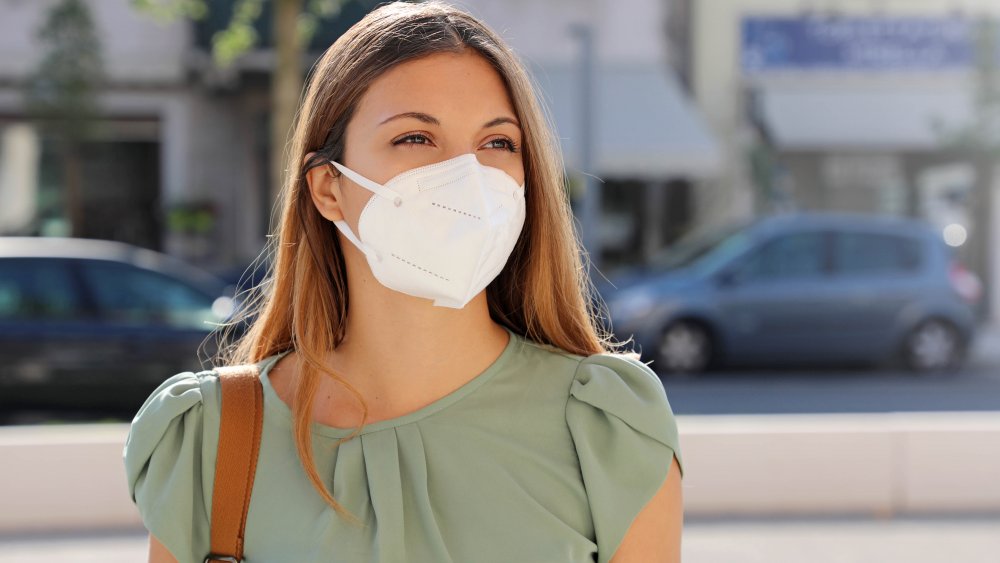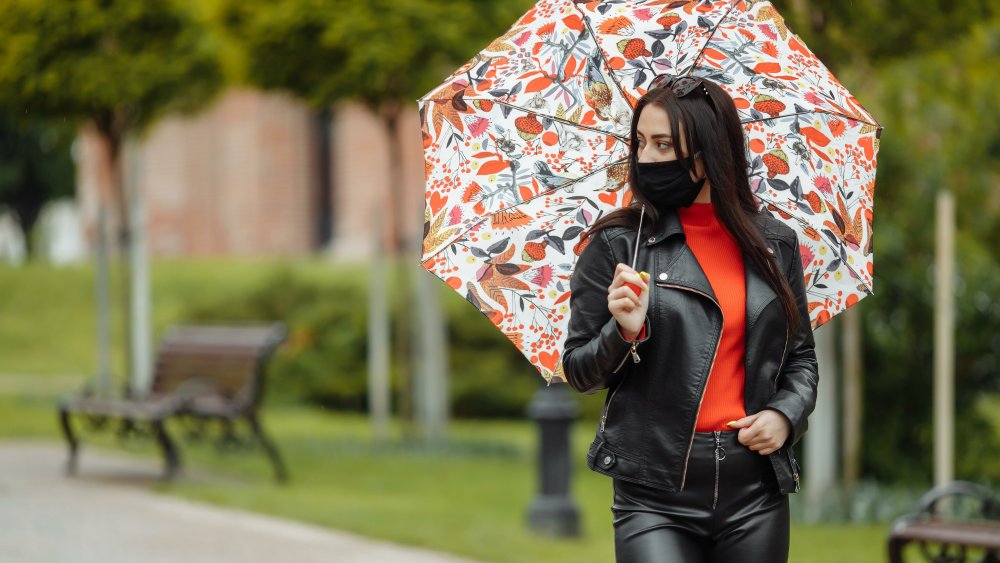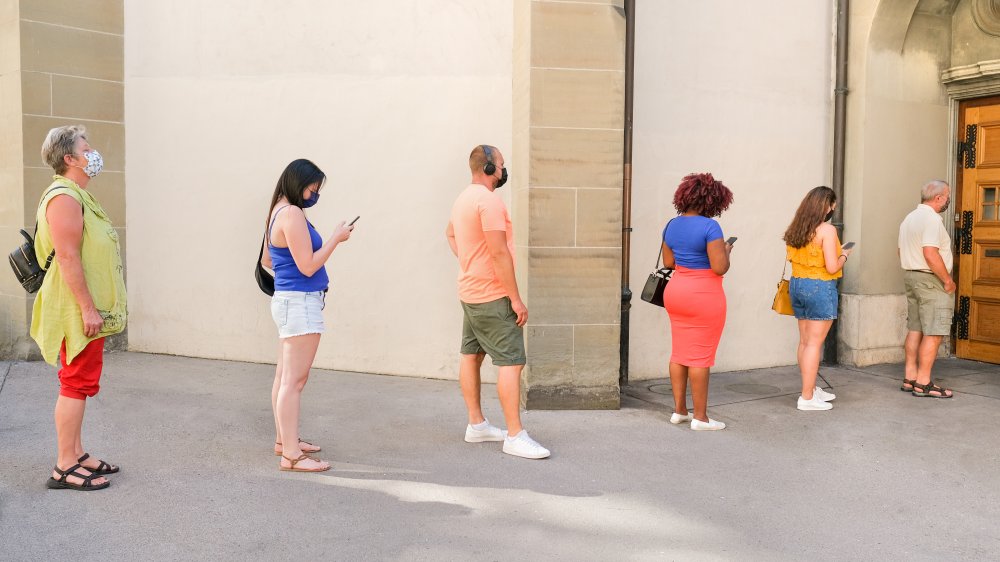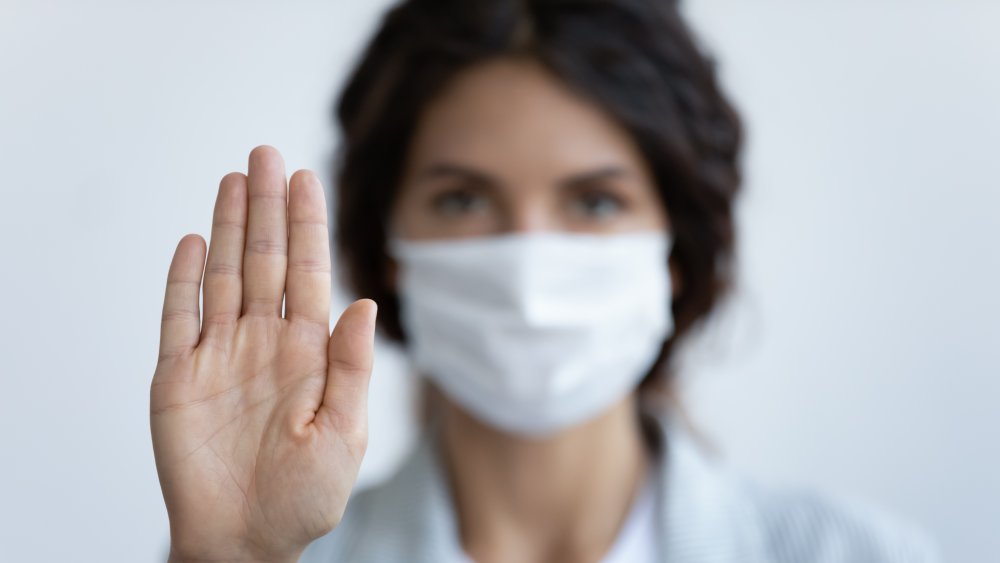Avoid These Serious Face Mask Mistakes At All Costs
Donning a face mask has become the new normal in 2020. Yes, gone are the days when we didn't know what "PPE" stood for. In response to COVID-19, the Centers for Disease Control and Prevention (CDC) advises that people wear masks while out and about, in public settings, or when in the company of people they do not live with — "especially when other social distancing measures are difficult to maintain." Wearing a mask is one of the biggest and most important steps we can all take to mitigate the risk of spreading coronavirus, and it seems easy enough, right?
While wearing one might sound fairly straightforward, there are a plethora of options to choose from and a surprising amount of mask-wearing faux pas one can potentially make. So what are the do's and don'ts of donning a face mask? We're breaking it down to help you navigate this uncharted territory. Here are some serious face mask mistakes to avoid at all costs.
Mistake: Not washing your reusable mask in between wears
Think of your mask as underwear for your face. You really don't want to wear your face mask day after a day without a proper washing. Yes, cloth masks should be laundered in between daily uses. Infectious disease expert, Dr. Amesh A. Adalja, explained to Health that during regular usage, your mask may become "contaminated with anything in the environment, like bacteria, viruses, and fungi." Adalja continued, saying, "And if you're not regularly washing it, it could itself contaminate other things you leave it with every time you take it off."
So how can you ensure your preferred face covering remains clean and hygienic? The CDC advises throwing it in with your regular laundry; just use a warm setting and regular detergent. You can also wash it by hand. It's equally important to make sure it's adequately dry before reusing. You'll want to transfer your mask to dryer and use the highest heat setting, or hang it in the sunlight (this method also ensures it won't shrink). You may also want to consider investing in a few cloth masks — perhaps one for each day of the week. This will lighten up your daily laundry load and ensure that you'll always have a clean — and dry — mask ready to go.
Mistake: Wearing your mask over your mouth only
We have all witnessed that person who pulls their mask below their nose so that they can smell a piece of fruit at the supermarket or give their schnoz a little air. Regardless of the reason, letting your nose hang out is a big no-no.
While you may think that your mouth is the super spreader, it's actually less offensive of the orifices. According to a study published in Cell, the nose actually spreads higher concentrations of COVID-19 than the mouth. So every time someone breathes out through their uncovered nose, they are able to shed more of the virus, thus increasing the likelihood of infecting other people. Furthermore, there is potentially greater "nasal susceptibility." As such, covering your nose might help offer some protection for you, as well.
This is why John Torres, NBC Medical Correspondent told Today that "bringing that mask up, covering the nose, is one of the most important steps you can take" to stop the spread of the Coronavirus and keep yourself — and loved ones — safe and healthy.
Mistake: Touching, adjusting, and fussing with your mask
We get it, masks are not the most comfortable addition to your accessories collection. If you are not accustomed to wearing them day in, day out, you may find yourself fiddling with them often — trying to adjust the nose bridge or pinch the sides. But all that touching is doing more harm than good; you could be contaminating your mask and spreading germs to your face.
If you have to touch your mask while out in public, you should first wash your hands, infectious disease expert Dr. Dean Winslow of Stanford Health Care told Business Insider. Don't have access to water and need to adjust your mask? You can use alcohol-based hand sanitizer, according to the World Health Organization (via Business Insider).
The Centers for Disease Control and Prevention also recommends taking heed when taking off your mask. You should only remove your mask once you're back at home and only touch the ear loops or head ties to remove. "Be careful not to touch your eyes, nose, and mouth when removing and wash hands immediately after removing," the CDC advised.
Mistake: Wearing a disposable mask inside out or backwards
Opting for disposable surgical masks? Pay attention as you put one on because there is actually is a wrong way to wear it. As explained by The Strait Times, most surgical masks feature three layers of material. The top and bottom layers are folded and the middle layer functions as a filter. But the important thing to note is that "there is only one way to wear them: with the coloured side facing outwards."
The side that should face inward and against your face is usually white in color, according to the World Health Organization, and made of an absorbent material. "So, if I cough, it absorbs it," Dr. Wing Hong Seto, the co-director of the WHO Collaborating Center for Infectious Disease Epidemiology and Control, explained to Bloomberg. The other side, often blue in color, is the "waterproof" side.
Furthermore, if your mask features a piece of flexible metal within one of the long sides, that side should be facing upwards with the metal piece pressed down against the bridge of your nose, thus ensuring a good, snug fit, according to Healthline.
Mistake: Wearing a mask with a valve
Those fancy masks with valve contraptions may look high-tech and have you assuming that this extra accessory makes them even safer. Unfortunately, this is not the case. Exhalation vent-style masks can do more harm than good in stopping the spread of COVID-19.
As explained by the Centers for Disease Control and Prevention, masks are meant to keep you, the wearer, from expelling respiratory droplets that can infect other people. Many masks that feature vents, however, permit humid air to be exhaled through that valve, essentially defeating the purpose of using one. Instead of trapping and containing germs, it helps spread them.
As noted by The Washington Post, these masks are generally meant to block the intake of pollutants or unhealthy construction materials — so save them for your next DIY demo project and stick with a traditional cloth mask or disposable face mask.
Mistake: Wearing an ill-fitting mask
When it comes to masks, one size does not fit all. Wearing a mask that is oversized can actually impede its purpose to stop the spread of germs. Dr. Cassandra M. Pierre, an infectious disease expert at Boston Medical Center explained to Allure that a proper fit helps a mask do its job: "Particles can't escape or get in around the edges of the mask when it's tight around your nose and mouth." Adjust your mask to eliminate any gapping or extra spaces.
Positioning is also key to ensuring efficacy. As previously mentioned, it is important that your mask is completely covering both your mouth and nose, as these are the areas that expel virus-containing droplets. But don't worry if your chin keeps playing a game of peekaboo. "Some masks go down over your chin, and that's okay, but the important parts to cover are your nose and mouth," Pierre confirmed.
Men with mustaches and beards might want to consider a little trimming, too. As noted by Moffitt Cancer Center, facial fuzz can intrude on the intended snug fit of a mask.
Mistake: Using a disposable mask for too long
Hence its name, a disposable mask is meant for one-time use. While it is best to wear it for a day and then move on to another one, some experts say that you can reuse it as long as you take some extra precautions. Jade Flinn, nurse educator at John Hopkins Medicine, told Yahoo! News that, in a pinch, you can put your disposable mask in a paper bag or a "clean [receptacle]" that has "good ventilation" and give the mask some time to "air out" before wearing it again. While you may be tempted to spritz your disposable mask with disinfectant spray in an effort to prolong its life, this should be avoided as you may end up breathing in all sorts of harsh chemicals.
If you do decide to reuse a disposable mask, be sure to chuck it if and when you notice any staining or damage, as advised by the Moffitt Cancer Center. No stapling ear elastics or scotch taping tears and holes; we appreciate the thriftiness, but that thing has got to go.
Mistake: Wearing the wrong mask
At the outset of the COVID-19 pandemic, masks were scarce. Fortunately, companies and individuals sprung into action to make cloth face coverings available to the public. While we should stress that any mask is better than no mask, there are certain types that are more effective.
According to ScienceDaily, a study led by Amanda Wilson, an environmental health sciences expert at the University of Arizona, sought to measure the efficacy of different masks and materials. "The denser the fibers of a material, the better it is at filtering," she explained. "That's why higher thread counts lead to higher efficacy. There's just more to block the virus." Some cloth masks even feature a pocket to insert an extra filter.
The research also found that a DIY mask made out of a single-layer cotton tee is "only slightly better than wearing no mask at all," whereas a scarf lowered the risk of infection risk by 44 percent after 30 seconds and 24 percent after 20 minutes. Interestingly, Wilson noted that other masks made from materials like silk "have electrostatic properties, which can attract smaller particles and keep them from passing through the mask as well."
Mistake: Not addressing or preventing skin issues underneath your mask
Have you heard the term "maskne"? It's exactly what it sound like: acne caused by wearing a mask for extended periods of time. Of course, it is a small price to pay to protect others and yourself from the spread of COVID-19, but hey, you might as well take some small preventative steps to at least try to ward off irritating blemishes and pesky pimples.
Dr. Noelani Gonzalez, cosmetic dermatologist, explained to Self that masks can trap humidity (and sweat), which will cause bacteria to grow, leading to eventual breakouts. Thankfully, maintaining a simple skincare routine can help. Cleanse, moisturize, exfoliate, and wear SPF (this will prevent mask tan lines) every day, as advised by Gonzalez as well as Dermatologist Carrie L. Kovarik.
Active maskne breakouts may require more mildly aggressive products, like benzoyl peroxide and salicylic acid. Finally, don't forget to wash your cloth mask regularly to keep bacteria at bay.
Mistake: Wearing a mask that's too tight
Wearing a mask is not at all dangerous. As confirmed by the Mayo Clinic, a face mask will not force you to breathe back in carbon dioxide or impede your ability to get enough oxygen. There are surgeons who wear masks for hours and hours at a time in the operating room without experiencing any harmful effects.
Still, a mask that is ill-fitting and too tight may cause you some discomfort. Of course, you'll want to keep your mask on while in public. but if it's causing you pain, you are more likely to take it off when you should not. As noted by CNet, you want your mask to fit snugly, but it shouldn't be so snug that it hurts. If your mask is too tight, it will also allow less space for comfortable breathing. A well-fitting mask made of 100 percent cotton will likely be more comfortable.
If sore ears are the problem, there are fixes for that, too. Try a headband made specifically with buttons to alleviate pressure on the ears or tie the strings with an S-ring hook at the back of your head, according to CNet.
Mistake: Wearing a wet mask
Word to the wise: You do not want to participate in a wet t-shirt mask contest. If you've been caught in an unexpected rain storm and your mask is soaked, you will want to swap it out for a new one as soon as you safely can. Likewise, if you have been working out and your mask is damp with sweat, you're going to want to replace it. You also shouldn't put on a mask that hasn't fully dried after being washed. And it may seem obvious, but just to lay it all out there: Don't wear your mask while swimming. However, do keep your distance from other swimmers.
As noted by the Centers for Disease Control and Prevention, wearing a wet mask can make it difficult for you to breathe. Plus, it won't even work that well. According to Infection Control Today, a wet mask has "increased resistance to airflow" and thus a reduced capacity for "filtering bacteria."
Mistake: Improperly storing your mask while out
If you've ventured back into the world, you are no doubt familiar with the awkward experience that is removing your mask in a semi-social situation. What do you do with it? Where should it go? How can you keep it handy and clean for when you need it again?
As advised by Sarasota Memorial Health Care System, you should keep a paper bag with you so that you can safely store your mask when you have to take it off. A Ziploc bag is another option. Whatever you do, though, don't shove it in your pocket or store it straight into your handbag. This is a recipe for contamination.
You can also consider investing in an accessory for your accessory — namely a face-mask chain or lanyard. This keeps your mask hanging around your neck when it's not on your face. "It's a good idea for people who seem to lose their masks when they're out running errands or exercising, and it would definitely be a convenient way for them to keep them on hand at all times," internist Nabeel Chaudhary told Health. Plus, there are all sorts of stylish options so you can even take your mask fashion up a notch.
Mistake: Thinking that wearing a mask means you don't have to socially distance
Wearing a mask is certainly a critical step in stopping the spread of COVID-19, but it doesn't mean that you shouldn't also take other precautions.
Shanina Knighton, registered nurse, told Well+Good, "If you're in a public setting with strangers, like a grocery store, and there's potential that you may come in contact with multiple people that you're not familiar with ... then it is proper to both socially distance and wear a mask at the same time." Staying six feet apart from others means you're less likely to come "in contact with those droplets" responsible for spreading the coronavirus. Your face mask will also help protect you "if you do come in contact with some of those droplets."
Furthermore, the expert explained that although masks definitely impede infection, they don't make you impervious to it. "The fact that you can breathe through it tells you that something can come in through that barrier, and COVID droplets are small enough that they would still be able to travel through the mask," she revealed.
Mistake: Not wearing a mask at all
There are plenty of big and small mistakes you can make in your mask-wearing pursuit. But the most serious error is not wearing a mask at all. As noted by the University of Maryland Medical System, cloth masks mostly helps to restrict the escape of droplets from your nose or mouth, potentially reaching and infecting other people. As noted by the Centers for Disease Control and Prevention, you should wear a mask even if you are not exhibiting symptoms; asymptomatic transmission of COVID-19 is possible.
Additionally, wearing a mask may help to keep you safe, too. Dr. Monica Gandhi, an infectious disease specialist at the University of California, San Francisco, noted that any type of barrier likely offers some impediment to breathing in a large amount of virus-carrying droplets. "The more virus you get into your body, the more sick you are likely to get," she revealed on the institution's site.
We're all in this together. By wearing a face mask, you do your part to mitigate risk for your community, your loved ones, and yourself. Mask up.
